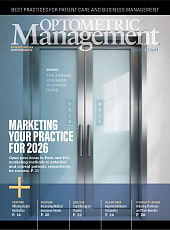A NEW 12-YEAR-OLD MALE patient presented with ongoing blur complaints. His father has keratoconus and wears scleral lenses. Not surprisingly, this young man was diagnosed with keratoconus as well. He was referred for corneal collagen cross-linking (CXL), but his insurance required proof of progression before approval.
In the meantime, contact lens fitting was attempted. Unfortunately, even with parental assistance, the patient was unable to apply scleral lenses, and he found corneal GP lens wear too uncomfortable to continue despite achieving a good lens fit and better vision.
Corneal sensitivity is only 1 of many elements that determine initial GP lens comfort; the sensitivity of the lid margin and conjunctiva, tear film stability, and dry eye, as well as general anxiety, pain tolerance, and other factors, also contribute (Carracedo et al, 2016; Nosch et al, 2020). The use of topical anesthesia to reduce corneal sensitivity during initial GP lens fitting can calm anxiety and increase tolerance for GP lens wear in many cases (Gill et al, 2017), though long-term use should be avoided due to toxic effects on the corneal epithelium (Lafreniere, 2023).
After the initial fitting, many GP lens wearers report improved comfort with their lenses over time. The processes that allow for this are unclear. Neurologic sensory adaptation is likely to play a role (Nosch et al, 2020). GP lens wear has been found to decrease corneal sensitivity; this has been linked to both hypoxic (eg, with polymethylmethacrylate [PMMA] wear) and mechanical mechanisms (as noted in orthokeratology patients) (Stapleton et al, 2019). Regardless of cause, corneal sensitivity recovers upon cessation of lens wear (Stapleton et al, 2019). Corneal nerve changes are also found with keratoconus (independent of lens wear), with a complex “chicken or the egg” relationship that is poorly understood (Spadea et al, 2013).
CXL, particularly epithelium-off, has been noted to cause neuronal changes within the cornea as well (Teo et al, 2022). These changes include reduced nerve density and decreased corneal sensitivity; however, corneal regeneration occurs readily over the following 6 to 12 months with sensitivity returning back to pretreatment levels (Teo et al, 2022). With more aggressive corneal surgeries (ie, extending deeper into the stroma), some permanently reduced nerve density and changes in nerve architecture may remain (Spadea et al, 2013).
Interestingly, an increase in GP lens tolerance for CXL has been reported, a possible result of reduced corneal sensitivity (Ünlü et al, 2017). This effect is temporary, but a few months’ wait could be sufficient to reattempt corneal GP lens wear on our young, previously intolerant patient. Once he is deemed safe to refit postoperatively, it will likely be worth taking the opportunity to reintroduce corneal GP lenses.
Corneal nerves are difficult to assess objectively (Figure 1) and there is still much to be learned about corneal sensitivity, from corneal hypersensitivity (neuropathic corneal pain) to hyposensitivity (neurotrophic keratitis) and everything in between. Why does the normally resilient corneal sensitivity function fail in these extreme examples, and how can we utilize or influence corneal sensitivity therapeutically? Gaining more knowledge in this area will no doubt help these patients but may also be beneficial in enabling potential GP lens candidates to comfortably wear their lenses from fit to follow-up.

References
1. Carracedo G, Martin-Gil A, Peixoto-de-Matos SC, et al. Symptoms and signs in rigid gas permeable lens wearers during adaptation period. Eye Contact Lens. 2016;42(2):108-114. doi: 10.1097/ICL.0000000000000153
2. Nosch DS, Joos RE, Müller D, Matt SM. General pain perception sensitivity, lid margin sensitivity and gas permeable contact lens comfort. Clin Exp Optom. 2020;103(6):766-771. doi: 10.1111/cxo.12995
3. Gill FR, Murphy PJ, Purslow C. Topical anaesthetic use prior to rigid gas permeable contact lens fitting. Cont Lens Anterior Eye. 2017;40(6):424-431. doi: 10.1016/j.clae.2017.07.005
4. Lafreniere JD, Szczesniak AM, Courtney E, Kelly MEM, Faktorovich EG. Topical analgesics for acute corneal pain: current options and emerging therapeutics. J Cataract Refract Surg. 2023;49(11):1160-1167. doi: 10.1097/j.jcrs.0000000000001225
5. Stapleton F, Chao C, Golebiowski B. Topical review: effects of contact lens wear on corneal, conjunctival, and lid margin sensitivity. Optom Vis Sci. 2019;96(10):790-801. doi: 10.1097/OPX.0000000000001429
6. Spadea L, Salvatore S, Vingolo EM. Corneal sensitivity in keratoconus: a review of the literature. ScientificWorldJournal. 2013;2013:683090. doi: 10.1155/2013/683090
7. Teo AWJ, Mansoor H, Sim N, Lin MT, Liu YC. In vivo confocal microscopy evaluation in patients with keratoconus. J Clin Med. 2022;11(2):393. doi: 10.3390/jcm11020393
8. Ünlü M, Yüksel E, Bilgihan K. Effect of corneal cross-linking on contact lens tolerance in keratoconus. Clin Exp Optom. 2017;100(4):369-374. doi: 10.1111/cxo.12470



